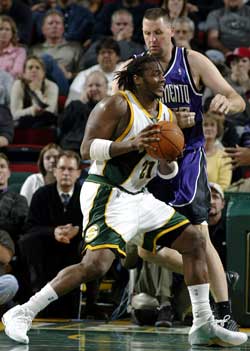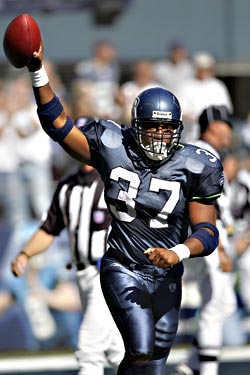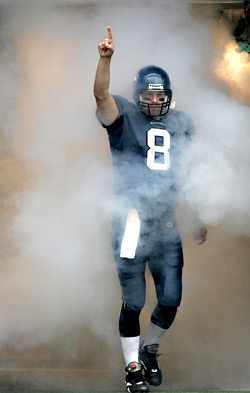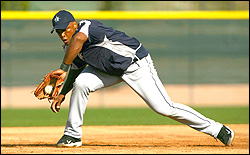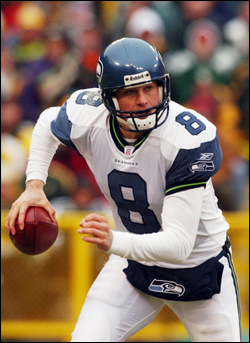The argument as to whether Seattle is a baseball town or a football town finally has been settled. It’s a basketball town.
That much might have been evident last winter, when from virtually nowhere the University of Washington men’s five wound down the regular season with enough W’s to make the NCAA tournament (albeit not for long). Further evidence arrived a few months later, when the Seattle Storm became the champs of the WNBA, disparaged as it is by many. (At a local bar, I overheard a road- company Jimmy Kimmel ask his buddy: “What would you like better? Finding a $20 bill on the sidewalk or having your WNBA team win a championship?”)
Exhibit C: the Seattle SuperSonics, and, for the time being, anyway, “super” seems nearly as accurate as it was 27 years ago, when the Supes started the 1977–78 campaign 5-17. Out of the country at the time, I wrote to a friend that I could hardly wait to get back to Seattle and not watch some Sonics games. Then the coach was replaced and the same Sonics came within minutes of winning the National Basketball Association championship, a feat they would accomplish the following year.
For comparison purposes, the current edition started the season against those perennial death-spiral guys known as the Los Angeles Clippers. The 30-point Sonic loss seemed to confirm the Vegas-odds wisdom that Seattle wouldn’t win 32 games this season. But by mid-November, the Green Team already had logged six victories, including a last-shot walk-off against a solid Toronto team followed by a Sunday, Nov. 14, 118-113 besting of Memphis, featuring a 34-point fourth-quarter comeback. Suddenly a ticket to a Sonics game was good for something besides emergency dental floss.
True: Even at 6-1 after Sunday’s comeback, the Supers don’t yet rival the crosstown Huskies for sellout potential—the UW basketballers having sold every seat in the arena except the ones with flush handles. That popularity comes with flooring a fivesome ranked in the national top 25. Moreover, savior coach Lorenzo Romar and staff recruited what is said to be the fourth best 2005–06 class in the country (behind Duke, Louisville, and Kentucky); and part of the charm of the UW program is that this and future b-ball teams will feature athletes whose games came to fruition at area high schools.
By contrast, the Sonics have players who seem to have come directly from a Gene Hackman movie. We thought they’d be hosers, but they’re actually Hoosiers. The crazy-coifed Danny Fortson, who looks like the love child Wes Unseld and Shirley Temple never had, was the main man in the 108-78 thumping of Sacramento on Nov. 10, cluttering up the key and the box score with 16 points and 13 rebounds. He’s part of a bench lined with guys who play as though they genuinely care about the outcome, this when a teamwide will to win in the NBA has seemed secondary to the really important stuff: TiVo, postgame dining destinations, etc.
The Sonics had promising starts in recent failed seasons and, of course, are not playing perfect basketball now, blowing a big lead against Toronto Nov. 12 at home before winning by one on clutch-sub Antonio Daniels’ stellar play (Daniels would contribute 28 points in just 32 minutes against Memphis). Coach Nate McMillan deserves more credit than any given player for bringing Seattle back after the opening-night choke in L.A. McMillan, to the extent one can in a league featuring players who make more per year than half of Haiti, has been hard- assing his guys. Most players have responded. Marquee man Ray Allen is often an unstoppable shooting guard. Forward Rashard Lewis, still just a kid, is exhibiting leadership skills on and off the court, delivering cogent quotes after most games. Luke Ridnour, no longer looking and playing like David among Goliaths, has a much better command of the court than we saw from the point guard last season. Jerome James and Reggie Evans never would threaten to set scoring records, but their physical presence can be intimidating. With Fortson (they got this guy for Calvin Booth?), Daniels, Vlad Radmanovic, and Nick Collison on the bench, McMillan senses he can sub without sacrificing leads. Indeed, it was Collison’s aggressive play against Memphis that prompted the fourth-quarter turnaround.
The Sonics also might benefit from the false promise of other local teams, ironic given that the Howard Schultz–led ownership continues to grouse publicly about its lease deal with a city that Supe execs say favors the other pro outfits. Fans, meanwhile, have seen all these sports-ownership machinations before and would prefer to keep their eyes on the ball. Few, however, even seem to recall that UW has a football program, if that’s what you call a soon-to-be 1-10 club (the record predicted here after the opening game). The 5-4 Seahawks squandered critical fan admiration even before revealing the new no-touchdown offense in the Sunday, Nov. 14, surrender to the Rams. Oh, yeah, and then there’s that 99-loss baseball team.
It’s enough to drive sports fans indoors (if only to sports bars during the current lengthy Sonics road trip), and, in this suddenly basketball-abiding town, the teams and the weather are doing just that.
